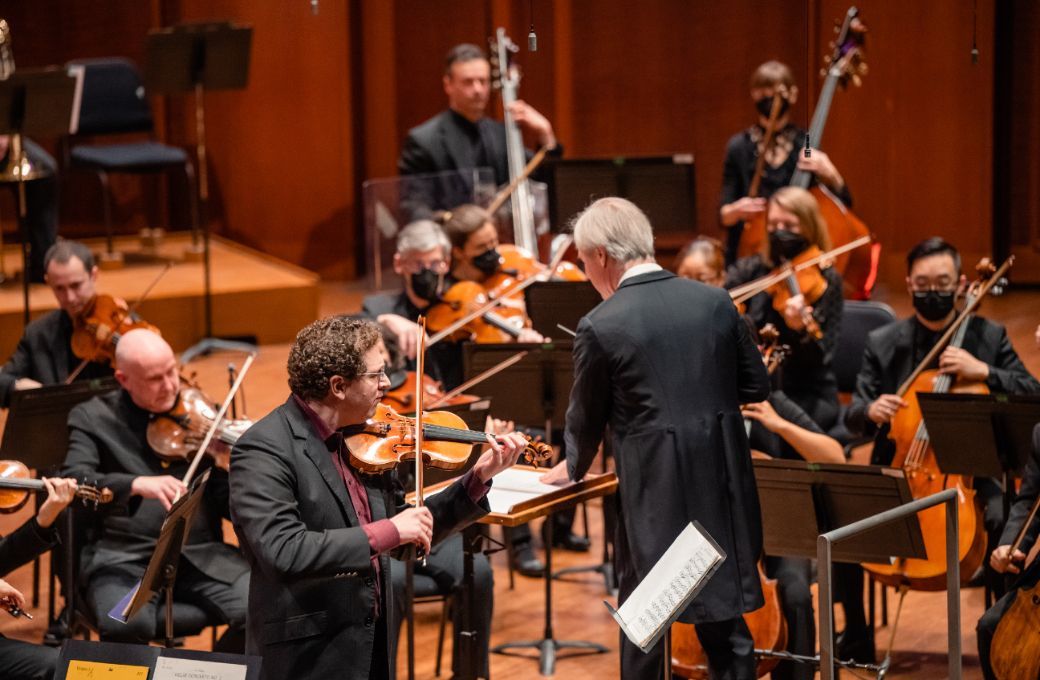Since it lacks a music director, the Seattle Symphony is presenting a smorgasbord of guest conductors throughout the season. These have been mostly younger artists still early in their careers, but David Robertson’s engagement marked the return of a seasoned conductor already well-liked by the players and in full command of a formidable talent.
While three canonical 20th-century composers shared the bill, Bartók’s Second Violin Concerto was the only work that could be called familiar. The Concert Românesc is an early work from the period before György Ligeti fled Hungary, when his compositional activity was scrutinized according to the dictates of Communist cultural policy and “decadent” modernism verboten. Yet despite the strictures, glimmers of the mischievous, wildly original composer who would emerge already permeate this colorful orchestral suite — precisely what bubbled to the surface in Robertson’s account.
Drawing on reimagined Romanian folk song – with the emphasis on “reimagined” – Ligeti delights with unusual sonorities and timbres meant to evoke “the spirit of the village bands”. Robertson choreographed each episode with narrative flair, letting the shadows loom and the little surprises and oddities tucked into Ligeti’s score pop out playfully – such as the unbuttoned, raucous fiddle solos that associate concertmaster Helen Kim made so characterful. Robertson’s own repertoire of gestures was great fun to watch. It emboldened the musicians to conjure a vividly stylized soundscape, dazzling with its rambunctious energy.
Following this auspicious start, concertmaster Noah Geller then stepped into the spotlight as the soloist in the Bartók, which was completed in 1938 (just 13 years before his fellow Hungarian’s Concert Românesc). Geller not only has the technical resources and imagination to handle Bartók’s demands – he shaped the first movement’s quarter-tone-laced cadenza with the edge-of-your-seat ferocity of a Jimmy Page solo – but clearly loves every cell of this masterpiece.
The variety of states of mind Geller articulated made for an epic adventure, fittingly instigated by the “bardic” tone, so beautifully matched with the harp strumming, of the opening. His exquisite tone was transportive in the variations of the Andante tranquillo, while Geller complemented sensitivity with exciting bravura, particularly in the final pages. (We heard the first version Bartók wrote for the ending.) Robertson proved an ideal conductor for this sort of concerto, which requires precision engineering to balance the sound and temperature from the orchestra. There was room for Bartók’s whispered tendernesses and whirling fire.

A legendary fiasco at its premiere in 1897 in St Petersburg, Rachmaninov’s First Symphony is a hugely ambitious symphonic debut. The personal story of its failure and of the devastating, long-reaching effects this had on the composer invites sympathy. Yet even with a performance as committed as the one Robertson shaped with the SSO, I could not be convinced that we’ve been missing out on a mistakenly buried treasure.
Rather, the First seems a frustrating conglomeration of incipient genius and inspired flashes that end up rambling and repeatedly run aground. A grim motto figure recurs across the long span of the piece with a fretful ubiquity that feels contrived, though Robertson admirably brought out its varied colors and elaborations. Intriguing instrumental choices contend with garish, overdone effects like the no-holds-barred fanfares of the finale. If he had not himself outright rejected the work, Rachmaninov likely would have radically revised and trimmed it. Still, the performance featured some impressive solo work – special kudos to Emil Khudyev on clarinet and guest timpanist Mike Kemp for his apocalyptic thunder – and made vivid this record of a young artist’s dark, untempered passions.


